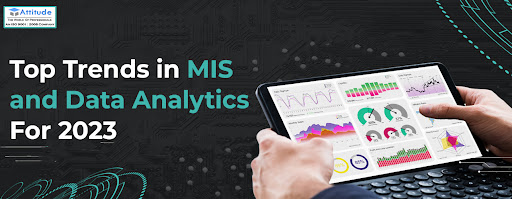Top Trends in MIS and Data Analytics for 2023
Introduction
In today's fast-paced digital
landscape, organizations are continuously seeking ways to harness the power of
data to gain a competitive edge. With the advent of advanced technology and the
evolution of data analytics, staying ahead of the curve is vital. The top
trends in MIS and Data Analytics for 2023 are set to redefine the way
businesses utilize data
analytics software to make informed decisions and drive success.
AI-Powered Data Analytics
Software: In 2023, the utilization of AI-powered data analytics will
become more prominent than ever. These intelligent systems will enable
organizations to analyze vast datasets efficiently and extract valuable
insights, helping businesses make data-driven decisions with greater precision.
Real-time Data Processing: The
need for real-time data processing will be a significant trend in 2023. As
organizations demand immediate access to insights, real-time data warehousing
solutions will become crucial, allowing them to act swiftly on changing market
conditions and emerging opportunities.
Data Security and Privacy: With
data breaches and privacy concerns on the rise, ensuring data security and
compliance will remain a top priority. Robust data analytics software and
secure data will be essential to safeguard sensitive information and maintain
customer trust.
Edge Computing and Analytics: Edge
computing will continue to grow in importance, particularly for industries like
IoT and manufacturing. The ability to process data at the edge, rather than
sending it to a central data center, will enhance efficiency and reduce
latency, thus improving decision-making processes.
Data Governance and Ethics: In
2023, organizations will place a stronger emphasis on data governance and
ethics. Regulations and industry standards will shape the way data is
collected, stored, and analyzed, promoting transparency and responsible data
management.
Self-Service BI Tools:
Self-service business intelligence (BI) tools will gain popularity as
non-technical users seek the ability to access and analyze data independently.
These tools will empower employees to make data-driven decisions without
relying on IT departments.
Advanced Data Visualization: Data
analytics will offer increasingly sophisticated data visualization
capabilities. These visualizations will help stakeholders better understand
complex data, making it easier to communicate insights and trends throughout
the organization.
Cloud-Based Data Warehousing:
Cloud-based data warehousing will continue to grow, offering scalability and
cost-efficiency. Organizations will migrate their data to the cloud to harness
the power of vast storage, processing, and analytical capabilities.
Augmented Analytics: Augmented
analytics, driven by machine learning and natural language processing, will
make it easier for users to gain insights from data. These technologies will
assist in data preparation, pattern recognition, and predictive analytics.
Cross-Functional
Collaboration: Collaboration between IT and business units
will become more integral. Data analytics and data will be designed to foster
cross-functional collaboration, allowing teams to work together to extract
actionable insights from data.
In conclusion
The field of Management
Information Systems (MIS) and Data Analytics is evolving rapidly in 2023.
Organizations that embrace these top trends in data analytics and data
warehousing will be well-positioned to make more informed
decisions, enhance efficiency, and stay competitive in an increasingly
data-driven world. As businesses navigate the data seas of 2023, the ability to
harness the power of data analytics and make the most of their data
capabilities will be essential for success.




Comments
Post a Comment